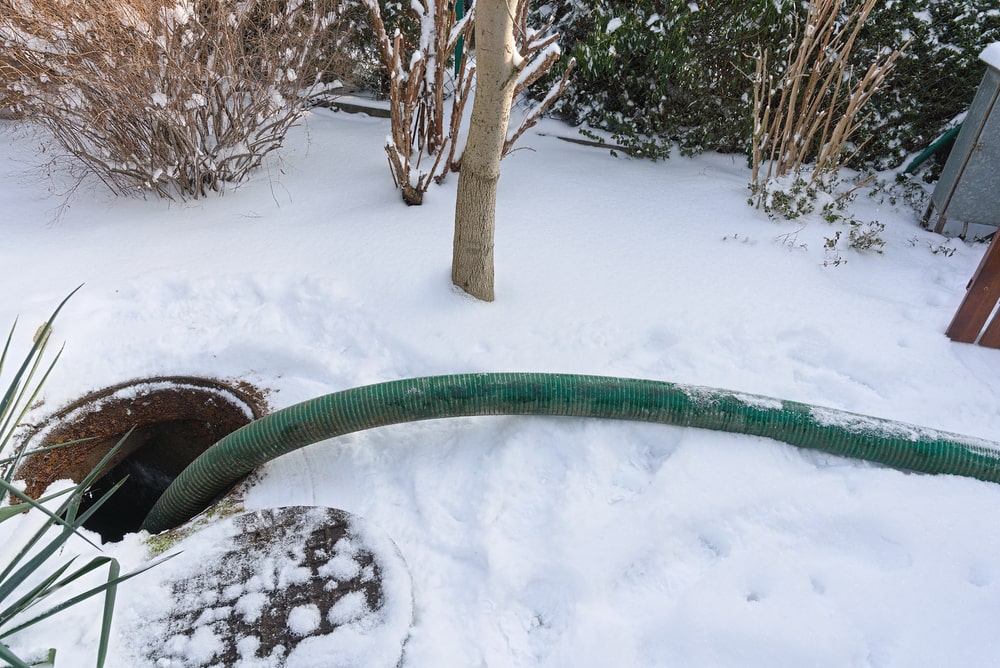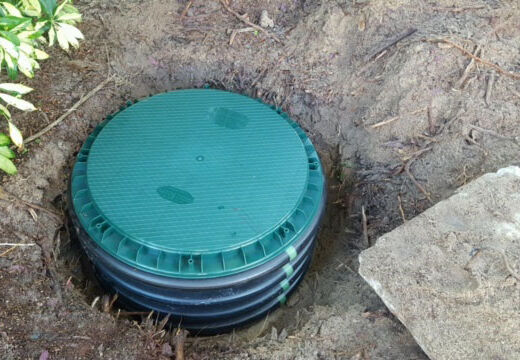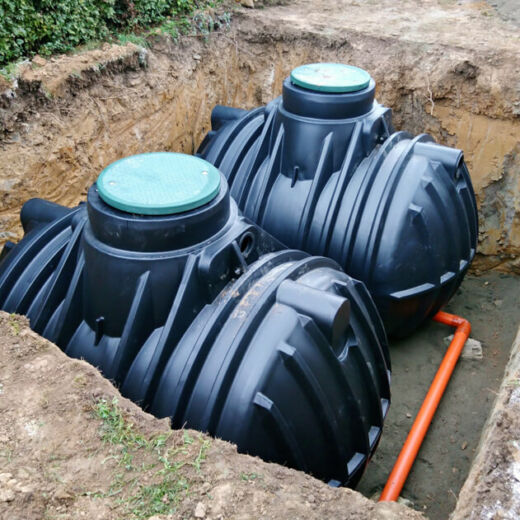Alberta’s cold temperatures and ever-changing weather conditions can have drastically negative impacts on septic systems. Frozen septic fields and frozen septic lines can lead to backups into the house and permanent cracks or damage to your septic system.
We are often asked if a frozen septic tank is possible. Technically, frozen septic tanks do not happen because they are buried at a depth where the temperature inside the tank combined with the flow of warm water prevents freezing inside the septic tank. However, extreme cold conditions can pose a threat to septic systems.
A frozen septic system can cause a lot of issues that are costly to repair and unpleasant to deal with. If an issue does occur, there are ways to fix it! Here are some ways to deal with a frozen septic tank or system.
The Main Causes of a Frozen Septic System
There are two main components of a septic system that can freeze:
- The soil treatment system (the drain field)
- The pipe that runs from your septic tank to the soil treatment system.
Septic drain fields rarely freeze, at least not to the point that the system will back up.
Critical freezing more often occurs in the line that leads from the septic tank to the drainage area (field, mound, etc) – this is called the ‘delivery line’. This line is intended to always be clear, as any water that remains in the pipe during the cold winter months can freeze solid, blocking the wastewater delivery.
If the delivery line is blocked from the septic tank to the drain field, the effluent will have nowhere to go. When this occurs, the effluent will continue to fill the septic tank with no ability to exit, eventually backing up into the house. If you are in such a situation, we provide emergency septic repair services.
Two Main Causes of a Frozen Delivery Line
If the delivery line has a droop in it, commonly called a ‘saddled’ line (it looks like a saddle), this can cause your line to freeze. Delivery lines are designed to be a direct slope, either up or down, towards the drainage area. This intended slope keeps the line clear of standing water. If the line has a saddle, the water will remain trapped in the lowered area, and when the surrounding soil is below freezing temperature, it turns into solid ice.
A Saddled Line
A saddled line can happen either as a failure in the design or an issue that shows up over time. When the delivery line is installed, the trench is backfilled. Over time, usually decades, the pressure from above can slowly settle and create the drooped line, eventually to the point where water rests in the low spot – much like how it settles into and fills the p-traps in your home’s plumbing system. As this continues, the low area grows in size and volume, as does the ice in winter.
Septic Plaque
Sometimes, the delivery line can become restricted with ‘septic plaque’, typically fats, oils, and grease that has solidified and settled over many years inside the line. This creates a restriction as the pipe diameter shrinks more and more as the plaque collects organic matter travelling through it.
This works in a very similar way to how our very own arteries can be clogged up with cholesterol, eventually leading to a heart attack – the plumbing in septic systems can fail for the same reason. These restrictions can freeze in cold winter months and restricts the effluent from being delivered to where it needs to go.
How to Prevent a Frozen Septic Tank or System
Frozen septic tanks, septic systems, and fields are often a structural phenomenon. Here are a few tips to prevent your septic system from freezing:
- Use your septic system regularly – The best way to keep your septic system from freezing is to use it regularly. Having the right amount of water running through your system will make sure that nothing sits for too long.
- Use the snow for insulation – It might sound counterintuitive, but don’t shovel the snow off your septic system and drain field. The snow acts as an insulator, keeping everything warmer underneath. It is wise to avoid walking or running machines over the septic system as well – snow can only act as insulation if it isn’t compacted. If you need additional insulation, you can use a straw, mulch, or grass clippings.
- Don’t leave water trickling – Some people will leave a trickle of water running in the winter to keep their pipes from freezing, but this is not a good idea for septic systems. The small trickle of water constantly running adds up to a LOT of additional water going into your septic system – it can easily add up to more water than your septic system was designed to handle.
- Keep up with routine septic tank inspections – Many rural homeowners prefer to schedule a septic system inspection before the cold months set in. However, a septic system inspection is beneficial year-round. Our goal is to identify any potential problems before they become costly issues.At SepTech Canada, we don’t just inspect the tank, as that’s only one part of the system. We check the integrity and condition of the entire septic system, including a full assessment of the drain field area and the condition of the mechanical and plumbing equipment, alarms, and more. Scheduling routine septic system inspections can be the difference between a healthy system and one that has you calling for emergency repairs in the middle of a cold snap.
Bonus Tip: If you notice your toilet refilling on its own from time to time when it hasn’t been flushed, chances are good that you have a leak, and the middle of winter is NOT the time you want to deal with those consequences!
What to Do If Your Septic System Freezes
The most important thing to do if your septic system freezes is to call a service provider. All frozen systems are repairable and immediate relief is often possible. A qualified technician can assess the situation and can often make recommendations to resolve freeze-ups and get your system back to functioning properly again. Whether you just need thaw relief or professional repairs, the only thing to do when your septic system freezes is to call a professional.
SepTech Canada is your go-to business when it comes to emergency septic services! We will dispatch technicians to diagnose the problem, confirm we can help, and offer immediate service. SepTech offers 24/7 emergency service, meaning that no matter the day or time if you need us, we’ll be there to help!
Some of the services we provide for frozen septic tanks or systems include:
- Steam thawing
- In-line hydro jet cleaning
- Camera investigation
- Mechanical service and replacement
- In-line heat trace installation
Where to find emergency septic services
SepTech Canada specializes in repairing residential septic systems in the counties of Strathcona, Sturgeon, Beaver, Leduc, and Parkland. Whether your septic alarm has been triggered or you notice some early warning signs of a septic system problem, call (780) 640-1518 today for any issues you have with a frozen septic system.




